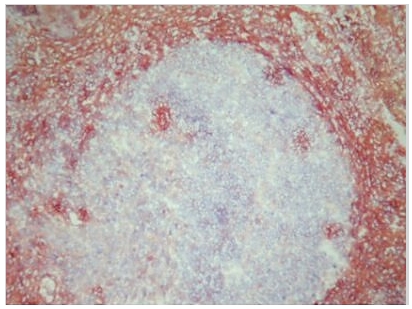MRP8/14 (S100A8/A9) Mouse Monoclonal Antibody [Clone ID: 27E10]
Specifications
| Product Data | |
| Clone Name | 27E10 |
| Applications | ELISA, FC, IHC, WB |
| Recommended Dilution | ELISA. Immunohistochemistry on Frozen Sections: 0.25 µg/ml (1/800). Immunohistochemistry on Paraffin Sections: 1 µg/ml (1/200). Digestion with Trypsin or Proteinase K pre-treatment for antigen retrieval is recommended. Recommended Positive Control: Human tonsil. Has been described to work in FACS and Dot blots. |
| Reactivities | Human |
| Host | Mouse |
| Isotype | IgG1 |
| Clonality | Monoclonal |
| Immunogen | Cultured Human monocytes. |
| Specificity | This antibody is ideally suited for the detection of early inflammatory macrophages and thus for the classification of acute stage inflammation in tissue sections and in smears, the characterization of tumorous tissues and the in vitro monitoring of peripheral blood cell cultures. Clone 27E10 is unique in that it recognizes an epitope on the MRP8/14 heterocomplex that is not exposed on the individual subunits MRP8 or MRP14. The antibody reacts with Human subpopulations of macrophages, monocytes and granulocytes; peripheral blood monocytes carry the antigen extra- and intracellularly, neutrophils only intracellularly. Antigen Distribution Isolated Cells: Monocytes carry the antigen both on the surface and intracellularly, granulocytes exhibit it only intracellularly. Up to 80% of monocytes in early cultures (24-48h) are positive. No reaction has been seen with lymphocytes or platelets. Tissue Sections: The antigen is found in macrophages in the red pulp of the spleen and liver. It is strongly expressed in macrophages from acute inflamed tissues (peridontitis, contact eczema, urticaria, erythrodermia) where some endothelial and epidermal cells may also express this antigen. It is normally absent on resident mononuclear phagocytes in healthy tissues (skin, gut, thymus). |
| Formulation | PBS, pH 7.2 State: Purified State: Lyophilized purifed IgG fraction from cell culture supernatant Stabilizer: 5 mg/ml BSA Preservative: 0.05% (v/v) Kathon CG |
| Reconstitution Method | Restore with 0.5 ml distilled water (= 0.2 mg/ml Stock Solution). |
| Concentration | 0.2 mg/ml (after reconstitution) |
| Purification | Affinity Chromatography on Protein G |
| Storage | Store lyophilized at 2-8°C for 6 months or at -20°C long term. After reconstitution store the antibody undiluted at 2-8°C for one month or (in aliquots) at -20°C long term. Avoid repeated freezing and thawing. |
| Stability | Shelf life: one year from despatch. |
| Background | MRP8 and MRP14 are members of the S100 family of proteins containing 2 EF hand calcium binding motifs. S100 proteins are localized in the cytoplasm and/or nucleus of a wide range of cells, and involved in the regulation of a number of cellular processes such as cell cycle progression and differentiation. S100 genes include at least 13 members which are located as a cluster on chromosome 1q21. The antigen is produced by the heterocomplex formation of MRP8 (S100A8 or Calgranulin A) and MRP14 (S100A9 or Calgranulin B), two calcium binding proteins of the S 100 protein family. |
| Synonyms | Calgranulin A/B, Calprotectin, L1 Protein, CFAG, P8, P14, CAGA, CAGB, CFAG, MRP-8, MRP-14 |
| Note | This antibody was produced serum-free, without fetal calf serum. Protocol: Protocol with frozen, ice-cold acetone-fixed sections: The whole procedure is performed at room temperature 1. Wash in PBS 2. Block endogenous peroxidase 3. Wash in PBS 4. Block with 10% normal goat serum in PBS for 30min. in a humid chamber 5. Incubate with primary antibody (dilution see datasheet) for 1h in a humid chamber 6. Wash in PBS 7. Incubate with secondary antibody (peroxidase-conjugated goat anti mouse IgG+IgM (H+L) minimal-cross reaction to human) for 1h in a humid chamber 8. Wash in PBS 9. Incubate with AEC substrate (3-amino-9-ethylcarbazol) for 12min. 10. Wash in PBS 11. Counterstain with Mayer’s hemalum Protocol with formalin-fixed, paraffin-embedded sections: The whole procedure is performed at room temperature 1. Deparaffinize and rehydrate tissue section 2. Incubate the tissue section with proteinase K for 7min. 3. Wash in distilled water 4. Block endogenous peroxidase 5. Wash in PBS 6. Block with 10% normal goat serum in PBS for 30min. in a humid chamber 7. Incubate with primary antibody (dilution see datasheet) for 1h in a humid chamber 8. Wash in PBS 9. Incubate with secondary antibody (peroxidase-conjugated goat anti mouse IgG+IgM (H+L) minimal-cross reaction to human) for 1h in a humid chamber 10. Wash in PBS 11. Incubate with AEC substrate (3-amino-9-ethylcarbazol) for 12min. 12. Wash in PBS 13. Counterstain with Mayer’s hemalum |
| Reference Data | |
Documents
| Product Manuals |
| FAQs |
{0} Product Review(s)
0 Product Review(s)
Submit review
Be the first one to submit a review
Product Citations
*Delivery time may vary from web posted schedule. Occasional delays may occur due to unforeseen
complexities in the preparation of your product. International customers may expect an additional 1-2 weeks
in shipping.






























































































































































































































































 Germany
Germany
 Japan
Japan
 United Kingdom
United Kingdom
 China
China





